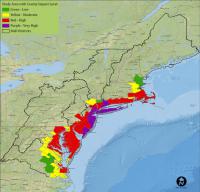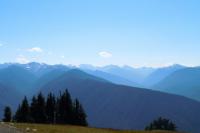-
Sea-level rise in twentieth century faster than in any previous century
Global sea level rose faster in the twentieth century than in any of the twenty-seven previous centuries, according to a new study. Moreover, without global warming, global sea level would have risen by less than half the observed twentieth century increase and might even have fallen. Instead, global sea level rose by about 14 centimeters, or 5.5 inches, from 1900 to 2000. This is a substantial increase, especially for vulnerable, low-lying coastal areas.
-
-
Virginia Tech continues addressing water crisis in Flint, Michigan

Last summer, a Flint resident reached out more than 500 miles to Virginia Tech for help, after officials said the orange water flowing into residents’ homes was OK to drink. That first round of testing was a wake-up call to the nation. Virginia Tech students and discovered more than 133 times the amount of lead on average was in the water than the maximum allowed by the U.S. Environmental Protection Agency (EPA).
-
-
New tool for coastal planners preparing for sea level rise

Scientists have developed a new model to help coastal planners assess the risks of sea level rise. Put to use on a global scale, it estimates that the oceans will rise at least twenty-eight centimeters on average by the end of this century — and as much as 131 cm if greenhouse gas emissions continue to grow unchecked.
-
-
Experts tackle U.K. flood risk
The U.K. Blue-Green Cities Research Project combines the expertise of academics from nine U.K. universities plus partners in the United States and China specializing in flood inundation modelling, computation fluid dynamics, sediment debris processes, river restoration and habitats, urban drainage infrastructure, environmental economics, uncertainty, flood risk management, and stakeholder engagement. The project’s goal is to make U.K. cities more resilient to flooding.
-
-
Predicting clay swelling for better nuclear waste disposal
Bentonite clay is planned to be used as a key barrier in the deep geological disposal of high-level nuclear waste. To ensure the safety of disposal, it is crucial to understand and predict the swelling behavior of bentonite clay. The swelling property, however, is regulated by multiple structural and environmental factors. A new model simulates the atomic-level interactions among the components of clay-water system, reproducing the swelling trends and swelling pressures measured by experiments with good accuracy.
-
-
Protecting Earth by crashing spacecraft into asteroids
Asteroids headed for a collision with the Earth, if found early enough, can be acted upon to prevent the potentially devastating consequences of an impact. One technique to divert an asteroid, called kinetic impact, uses a spacecraft to crash into the body at high speeds.
-
-
Protecting the grid from weather geomagnetic storms
On 9 March 1989, a huge cloud of solar material exploded from the sun, twisting toward Earth. When this cloud of magnetized solar material — called a coronal mass ejection, or CME — reached our planet, it set off a chain of events in near-Earth space that ultimately knocked out power to the Canadian province Quebec for about nine hours. Though CMEs hit Earth often, those with the potential to shut down an entire power grid are rare — and scientists want to make sure that next time, we are prepared. Because space weather can have — at its very worst — such significant consequences, scientists from NASA are creating models to simulate how space weather can impact our power grid.
-
-
Four billion people affected by severe water scarcity

There are four billion people worldwide who are affected by severe water scarcity for at least one month a year. This alarming figure is much higher than was previously thought. In the first research of its kind, researchers identified people’s water footprint from month to month, and compared it to the monthly availability of water.
-
-
Russian govt. behind attack on Ukraine power grid: U.S. officials
Obama officials said that Russian hackers were behind a December 2015 cyberattack on Ukraine’s power grid. The attack caused power outages and blackouts in 103 cities and towns across Ukraine. Elizabeth Sherwood-Randall, deputy Energy Secretary, made the comments to a gathering of electric power grid industry executives.
-
-
Better Greenland, Antarctica sheet modeling helps predict sea-level rise
The Greenland and Antarctic ice sheets will make a dominant contribution to twenty-first century sea-level rise if current climate trends continue. However, predicting the expected loss of ice sheet mass is difficult due to the complexity of modeling ice sheet behavior. Better to understand this loss, a team of Sandia National Laboratories researchers has been improving the reliability and efficiency of computational models that describe ice sheet behavior and dynamics.
-
-
Extrusion technique creates new fuel from depleted uranium
Advanced nuclear reactors will use new types of fuel. To ensure such systems are safe, experimental fuel samples must be fabricated and tested in safe research environments. Marking an important step toward the advancement of a new type of reactor, Idaho National Laboratory (INL) employees recently completed the first successful test of fabrication equipment in the Experimental Fuels Facility (EFF). Specifically, they finished depleted uranium extrusions — a process of shaping material by forcing it through a die.
-
-
World economy unlikely to stop relying on fossil fuels: Study
On the heels of last year’s historic climate agreement in Paris, a new study concludes that fossil fuel consumption is likely to grow without clear and decisive global action to put an adequate price on carbon dioxide emissions and increased clean energy technology.
-
-
Levees may make flood risk higher, not lower

People living behind levees on floodplains may not be as immune to flood damage as they think, according to results of a new study. U.S. floodplains are lined by more than 100,000 miles of levees, many of which are in questionable states of repair.
-
-
Ending civilian use of highly enriched, weapon-grade uranium
Efforts to convert civilian research reactors from weapon-grade highly enriched uranium (HEU) to low enriched uranium (LEU) fuels are taking significantly longer than anticipated, says a report from the National Academies of Sciences. The report calls for the federal government to take immediate steps to convert civilian research reactors currently using weapon-grade HEU fuel to a lower-enriched HEU fuel while awaiting the qualification of new LEU fuel.
-
-
Putting a price on groundwater, other natural capital

Most people understand that investing in the future is important, and that goes for conserving nature and natural resources, too. But in the case of investing in such “natural” assets as groundwater, forests, and fish populations, it can be challenging to measure the return on that investment. A Yale-led research team has adapted traditional asset valuation approaches to measure the value of such natural capital assets, linking economic measurements of ecosystem services with models of natural dynamics and human behavior.
-
- All
- Regional
- Water
- Biometrics
- Borders/Immig
- Business
- Cybersecurity
- Detection
- Disasters
- Government
- Infrastructure
- International
- Public health
- Public Safety
- Communication interoperabillity
- Emergency services
- Emergency medical services
- Fire
- First response
- IEDs
- Law Enforcement
- Law Enforcement Technology
- Military technology
- Nonlethal weapons
- Nuclear weapons
- Personal protection equipment
- Police
- Notification /alert systems
- Situational awareness
- Weapons systems
- Sci-Tech
- Sector Reports
- Surveillance
- Transportation
Advertising & Marketing: advertise@newswirepubs.com
Editorial: editor@newswirepubs.com
General: info@newswirepubs.com
2010-2011 © News Wire Publications, LLC News Wire Publications, LLC
220 Old Country Road | Suite 200 | Mineola | New York | 11501
Permissions and Policies
Editorial: editor@newswirepubs.com
General: info@newswirepubs.com
2010-2011 © News Wire Publications, LLC News Wire Publications, LLC
220 Old Country Road | Suite 200 | Mineola | New York | 11501
Permissions and Policies
